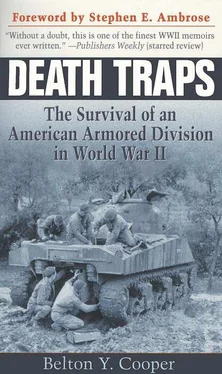After the war, Medaris was promoted to major general and organized the Army Ballistic Missile Agency at Redstone Arsenal in Huntsville, Alabama. Working with him in developing ballistic missiles and the nucleus of our space technology was the group of German rocket scientists, led by Dr. Werner von Braun, who had surrendered to our troops in southern Germany as we were evacuating the V2 assembly plant material from Nordhausen. Although the cost of capturing these facilities had been high, the action allowed the United States to win the Cold War and develop a space program.
Because the division constantly sent information to the troops, and we could pick up the BBC news broadcasts, we knew that the Russians had reached the outskirts of Berlin and had begun the final assault on the city. The rubble of a heavily bombed-out city can make formidable defense positions, and the Germans loyal to Hitler made the Russians pay dearly. We were glad that it was the Russians instead of us doing this fighting. Finally, we heard that the city had fallen to the Russians and that Hitler was dead.
My first reaction was that Hitler had been killed by the Russians; I learned later that he had died by his own hand. On May 7 we got the word that General Jodl had surrendered. On May 8 the ceremony was repeated in Berlin for the Russians. For the 3d Armored Division, the war in Europe had finally come to an end.
Darmstadt and the Army of Occupation
Shortly after V-E Day, the division was ordered south to Darmstadt. We proceeded down the autobahn over the gently rolling hills of western Germany south of Kassel.
The road was intact except for the bridges. Most of them had been blown; in some instances only one span going north was gone. Perhaps the Germans didn’t have time to mine both spans. It was a simple matter to cross over to the other lane of the road.
When we reached the northern outskirts of Frankfurt, it was obvious that the city had been heavily bombed but had not taken as much punishment as Cologne. The primary streets had been cleared of rubble, and we continued south past the railroad station to the Main River.
In moving through the northern part of the city, we passed near a large, low-lying brownstone complex that had been the headquarters for I. G. Farben, the largest chemical company in Europe. The complex was soon to become SHAEF headquarters. We crossed the Main River on a Bailey bridge, reinforced to take our M26 tanks. All the bridges across the Main had been blown, and our engineers were working feverishly to replace the major ones as quickly as possible with temporary bridges.
After crossing the river, we passed a large airport. The woods around it had numerous small indentures cut into them about two hundred feet wide and six hundred feet deep. The tarmac had been extended into the indentures, which were used to park aircraft. Although the airport had been bombed and strafed, more than two thousand planes, including Me 109s, FW 190s, and Ju 88s, had survived in these spaces completely unscathed. I was amazed that with this many planes intact, the Luftwaffe didn’t put up a better showing in combat during the last days of the war. Although there was a shortage of aircraft fuel, it appeared that the shortage of pilots was the main reason for the collapse of the Luftwaffe.
As we threaded our way through Darmstadt, I was shocked to see the degree of destruction. The British had bombed the city during a night raid in February. The target was the Merck Chemical Works, on the northern outskirts. On the night the raid took place, strong winds blew from north to south, carrying the flares that were dropped over the chemical plant southward over the center of the city. When the first bomber dropped its incendiaries and started fires in the center of the city, the remaining bombers dropped their incendiaries on the same flaming targets.
Once a fire of this size got started, the tremendous heat generated by the flames caused the smoke and other combustion gases to rise rapidly. This in turn caused air to rush in, bringing in oxygen to further accelerate the rate of combustion. This miniature hurricane, known as a firestorm, not only consumed all the oxygen from the area but replaced it with carbon dioxide and carbon monoxide. These combustion gases, being heavier than air, cascaded around the entire area surrounding the fire. In the residential area that we moved into, approximately a mile south of the fire ring, the people either suffocated or were asphyxiated by the falling gases. The effect was devastating. Of a total population of about sixty thousand people, more than forty thousand died in this inferno.
The maintenance battalion moved into a lovely suburban residential area about a mile and half south of the damaged city. We set up our shop in a large, modern brick and stone building that had been designed as a repair garage for the city streetcar system. Across the street from the shop was a handsome park with a large swimming pool surrounded by numerous playing fields. Adjacent to this was an arboretum of several acres with numerous walking trails.
Many tasteful homes surrounded this park, and we took them over as our living quarters. Most had been abandoned because the people who lived here were high in government and business circles, and with their Nazi connections they were afraid of American reprisals.
We lived in a large home near a swimming pool that was half full of water with a lot of dead leaves and tree branches in it; we were afraid to swim in it because of possible contamination. Battalion headquarters took over the largest home in the area, across the park from us. It had been the home of the Merck Chemical Works director general and was probably one of the finest homes in Darmstadt.
After ten months of combat, we tried to relax in our new quarters and take advantage of every amenity.
Captain Ellis, commander of headquarters company, obtained the services of two Latvian women to cook at the officers’ mess. They were both large, heavyset peasant women who had been taken forcibly from their homes and made to work as slave labor in German war plants. Not knowing the whereabouts of their families or friends, or if any of them had survived, they were waiting to return home. They soon became good cooks and learned to speak passable English.
One day a German woman in her middle thirties came to the back door of the officers’ mess. Although her dress was somewhat shabby, she looked neat and composed. She asked to speak to the commanding officer.
The cooks called Captain Ellis, and he talked with her. The army had imposed a strict ban on any contact with German civilians unless it was absolutely official. The nature of her request appeared to be official business.
She spoke good English and was obviously educated.
She said that this had been her home and that her father, now deceased, had been the director general of Merck Chemical Works. She was living with the nuns at the Catholic hospital nearby and was helping take care of wounded German soldiers. While living in this house, she had planted a vegetable garden in the backyard and wanted to know if she could tend the garden and take some of the vegetables back to the hospital to supplement her patients’ diet.
She seemed immensely grateful when Ellis gave her permission to do this. She came every day thereafter to weed and water the garden and keep the edges neatly trimmed.
Although we were not supposed to fraternize with German civilians, it was difficult to ignore her, and gradually her tragic story came out. Her father’s position was comparable to that of the president of a corporation in the United States. All high-ranking German industrialists were either members of the Nazi Party or were strong Nazi supporters. As the daughter of a relatively high German official, she had grown up in an aristocratic society. She had attended the best schools in Germany and as a young lady had gone to both France and England to attend finishing schools. She was fluent in French and English. After school in England, she returned to the ranks of high Nazi society. She married a young captain in the German army and had two daughters. While her husband was away on the Russian front, she and her young daughters lived in this house with her mother and father. They received word that her husband was killed on the Russian front a few months prior to the end of the war.
Читать дальше












